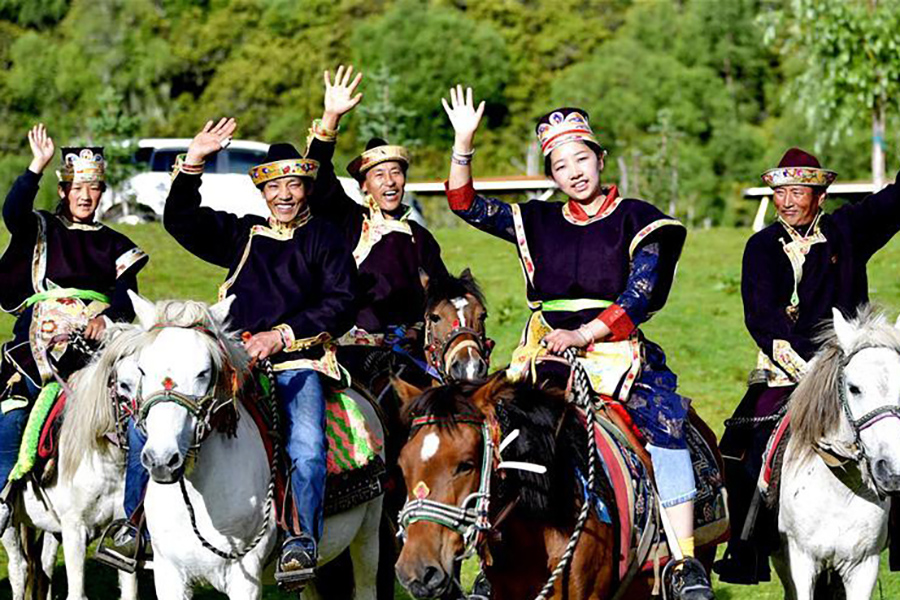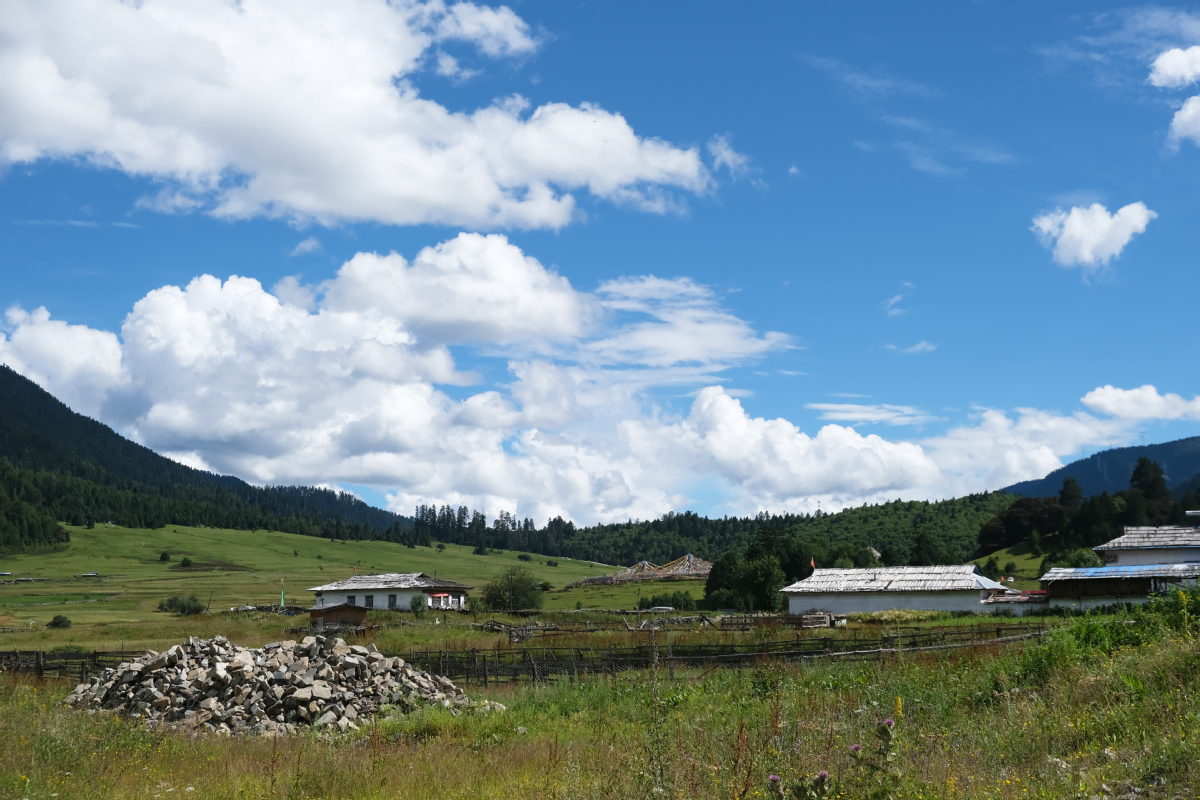
Herdsmen wave to tourists in Lulang International Tourism Town, on July 26, 2020. [Photo/Xinhua]
Hu Xiongying, who used to work at Guangdong Provincial Tourism Holdings Co Ltd, was assigned to Tibet autonomous region eight years ago, under the partner-assistance program between the two regions.
Although most of his colleagues went back to Guangdong after a three-year-rotation, Hu volunteered to extend the stay twice, devoting himself to Lulang, a remote township in Nyingchi, and helping to lift locals out of poverty by sustainable economic development.
Located in the valley of southern Tibet, Lulang is famous for its pleasant weather and rich natural resources, with an annual average temperature of 12 degrees Celsius, and forest coverage exceeding 80 percent of the township's total area.

Locals' homestays are set under a blue sky dotted with clouds at Lulang International Tourism Town, on July 30, 2021. [Photo by Zhao Shiyue/chinadaily.com.cn]
Tourism vitalizes rural township
For hundreds of years, Tibetan residents here earned a living by farming and raising livestock, barely making ends meet, with a slim income.
In 2017, the rural revitalization strategy was proposed as a key move for the development of a modernized economy at the 19th National Congress of the Communist Party of China.
The roadmap detailed plans to cultivate new industries and modes of business in the countryside, upgrade infrastructure, enhance public services and boost rural governance.
When Hu and the team came to Lulang, they found the distinctive characteristics of the township lay in its amazing highland scenery, and tourism must be the best way out for locals to shrug off an impoverished life.

Horses stand under a tree in this highland scene in Lulang, on July 30, 2021. [Photo by Zhao Shiyue/chinadaily.com.cn]
After about four years of construction, Lulang International Tourism Town officially opened in 2017.
"Guangdong government took the lead to invest 1.3 billion yuan ($200.59 million) into the project, which also attracted social capital, including Poly Real Estate, Evergrand Group and Pearl River Investment, adding over 2.5 billion yuan," Hu said.
Based on the concepts of "innovation", "openness", "sharing", "coordination" and "green", the town strengthens an integrated layout of natural landscapes, Tibetan culture and modern tourism facilities.

Lush green mountains in the background frame this view of Lulang International Tourism Town, on July 30, 2021. [Photo by Zhao Shiyue/chinadaily.com.cn]
Three high-end hotels, several boutique inns and over 40 shops and restaurants created about 2,500 jobs, transforming the local labor force from farming to engaging in the service industry.
Villagers began to run homestay businesses, charging about 400 yuan per room during peak season in summer, with a family's income hitting 300,000 to 700,000 yuan yearly.
According to official statistics, more than 820,000 tourists came to Lulang in 2019, generating income of 78 million yuan.
Locals also enjoy benefits from the upgraded public infrastructure facilities.
"A sewage processing plant, trash station and 5G base station have been built up in the town," Hu said, "with a museum, school and hospital to operate in the future."

Hotels are seen at Lulang International Tourism Town. [Photo provided to chinadaily.com.cn]
Partner assistance programs boost ethnic unity
Partner assistance usually refers to pairing local governments with each other to support the development of a certain region or sector under the overall coordination of the Chinese central government.
It facilitates sharing of material and fiscal resources, as well as intellectual expertise, and features complementary advantages and mutual benefits.
Since 1994, Guangdong and Fujian provinces have been implementing such projects in Nyingchi city.
The city's GDP in 2014 expanded 33 times than 20 years ago, and net income of farmers and herdsmen grew eight-fold in comparison to that in 1994, data from Nanfang Daily showed.
By offering medical services, education support and industrial development guidance to less developed areas, the partner assistance mode plays an important role in ethnic unity, building a strong tie between Tibetans and Han to achieve common prosperity.

